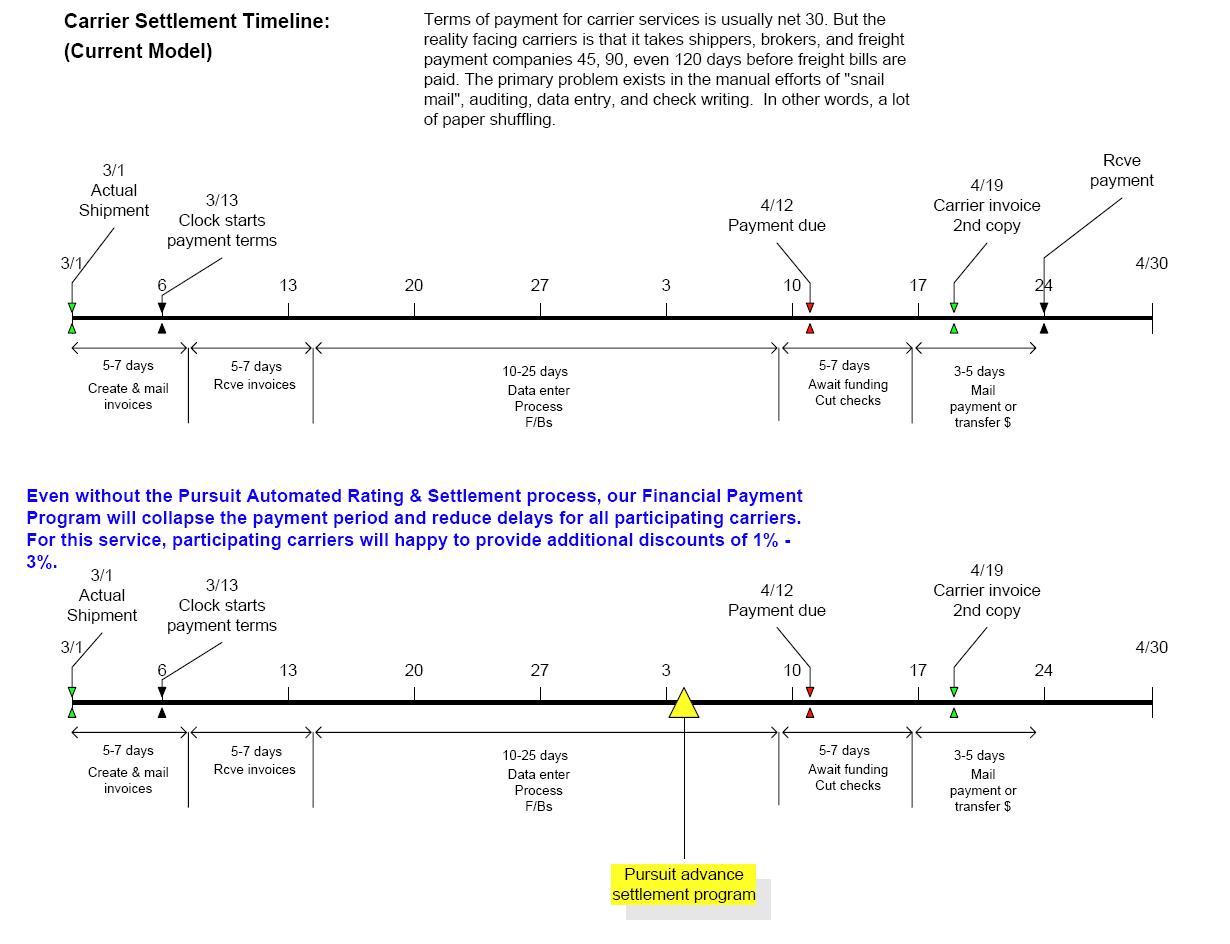Pursuit’s TMS solution provides many different avenues that can result in significant cost savings and building a strong return on investment for your organization. While actual returns may vary due to the unique characteristics of each business, our experience has allowed us to develop some generic ROI guidelines. These estimates should be helpful in determining how Pursuit’s technology & capabilities can deliver Value to your business.
Contract Management – Online support of contracts and rates in a real time shared environment can enhance the communication of vital information across the enterprise. True rate comparisons across all modes, not only enabling correct core carrier selection but optimal use of modes results in freight cost savings. The cost of administering this information is greatly reduced through a web-native process. Client contracts that represent uplifts or unique discounts provide a unique method to share price information in addition to cost. This pricing/costing exercise is normally a time consuming and manual process.
True rate comparisons across all modes, not only enabling correct core carrier selection but optimal use of modes results in freight cost savings. The cost of administering this information is greatly reduced through a web-native process. Client contracts that represent uplifts or unique discounts provide a unique method to share price information in addition to cost. This pricing/costing exercise is normally a time consuming and manual process.
* ROI can exceed 25% of the current costs of communication and administration for this process.
Compliance – The capability and support where the correct contracted carrier is consistently selected based on cost and service. Combined with the Contract Management function above, cost-effective negotiated contracts can be leveraged across the global enterprise.
* ROI is conservatively estimated at 3-5% of total freight cost.
Mode Shift and Aggregation – Improved operational capability that allow a business to use optimal or efficient or correct modes of transportation. Aggregation allows multiple shipments to be consolidated reducing the possibility of utilizing inefficient or incorrect modes thus greatly reducing the per shipment cost and tonnage rates.
* ROI ranges from 2%-6% of total freight cost.
Route Optimization – The ability to consolidate shipments and create multiple stop truckload moves as well as the construction and utilization of pools and mode skipping. Optimization can occur for all locations from a single management point. Shipment consolidation from single origins or to single destinations provides ROI, but combined with the ability to optimize routes will result in substantial ROI. The combined ability to route freight to and from multiple facilities and also incorporate the use of pooling and cross docking results in a truly cost effective supply chain.
* ROI at 4%-8% of total freight cost.
Multi-Enterprise Optimization – Users across divisions, or companies are allowed to combine shipments thereby developing routes that are mutually beneficial. The broader view generally provides more saving opportunities.
* ROI at 6%-12% of total freight costs.
Communications and Integration – EDI and VAN costs are often a very large cost component of gaining visibility and linkage with transportation data such as ASN notification, status updates and tender processes. New methods of direct linkage, transport technologies and mapping capability can greatly reduce the costs typically associated with these activities.
* ROI can exceed 70% of total communications costs.
Visibility – A huge advantage is the capacity to integrate information from communications and operations across your enterprise to authorized users. Advanced visibility can provide cost benefit in a number of different ways. In-transit status and the reduction of pipeline inventory can yield significant savings results. Additional value is derived from improved customer satisfaction based on real time availability of data. In an IBM survey, Chief Supply Chain Officers indicated “lack of visibility” as their number one problem within their supply chain.
* Visibility ROI goes far beyond simple costs savings and exact estimates vary widely (i.e. what’s the cost of losing a customer?)
Proof of Delivery – While agreeably hard to demonstrate true dollar value, the visibility of What is delivered and When is a valuable aspect of your company. With the increased scrutiny on company financials, accurate revenue accruals are essential to business operations. A good TMS will capture and display status messages from any carrier from any mode when goods are actually delivered. These status messages or notifications provide the kind of detailed backup required in today’s financial requirements allowing companies to accrue revenues quicker and with more confidence! POD provides valuable carrier and supplier compliance information but also provides the triggering mechanism to execute the settlement or invoicing process; improved efficiency of POD helps in speeding up the cash cycle for billing.
* ROI for this function is priceless!
Settlements and Freight Bill Payment – Automation of Freight Bill Payment activities can have a significant impact on streamlining your business. Cost savings from electronic transmittal of rated payment information, electronic payment and automated match pay in a shared environment can all drive large efficiencies and cost savings. Time and costs associated with allocations, accruals and disputes can be greatly reduced while improving accuracy and information availability.
* ROI and estimated savings result can exceed 50% of the cost of administering and auditing current freight bill process administration. (This does not include the benefit of accurate and timely support of financial processing.)
Process Improvement/Automation – Typical transportation processes are traditionally manual, labor intensive and re-active in nature. Good TMS technology is designed to support best of breed transportation processes and provide a pro-active, manage-by-exceptions environment.
* ROI – The improvements in operations and administration allow resources to be allocated to productive cost reducing and revenue generating activities.


